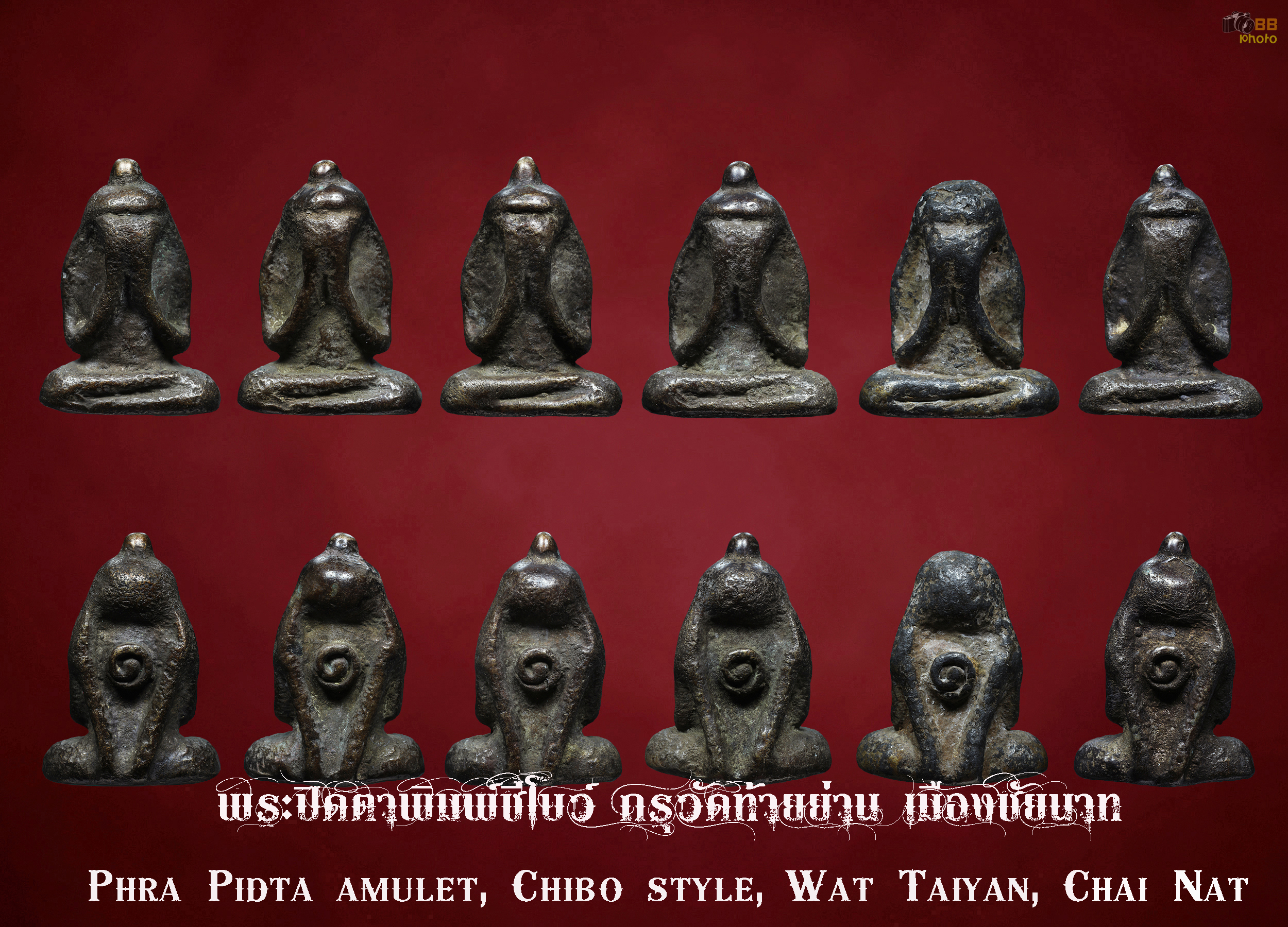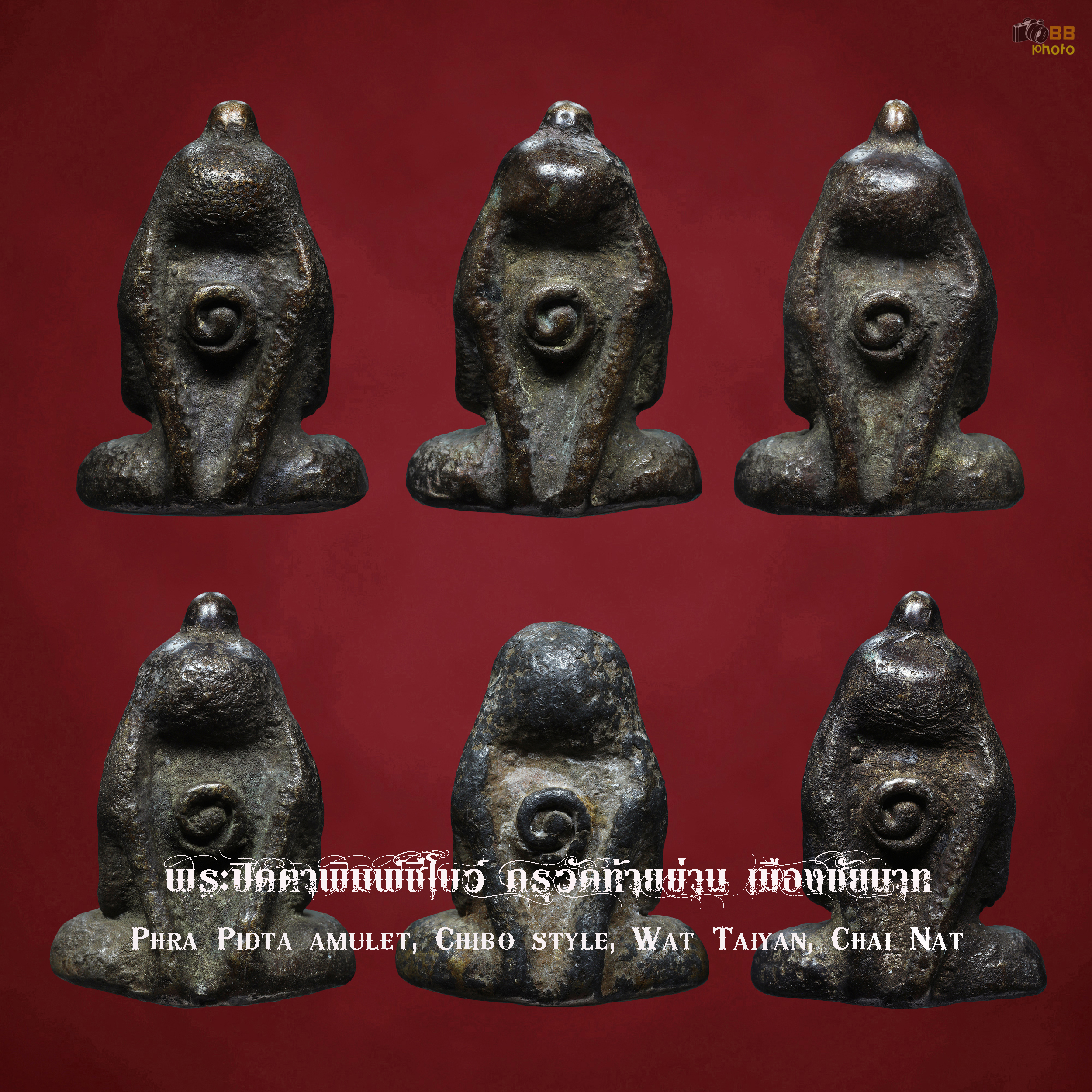Phra Pidta, Wat Taiyan, another great Benjapakee Phra Pidta Yodkhunphon
Details
Phra Pidta, Wat Taiyan, Chai Nat Province, which the older generation often calls 'Phra Pidta Bo Yan', is considered the only Phra Kru in the Benjapakee set of metal Phra Pidta (antimony ore) that has been made for the longest time. With its excellent and complete Buddhist power, it has been the ultimate pursuit for collectors of old amulets and Phra Pidta lovers from the past to the present. However, since it is very difficult to find the real thing, its value has been increasing steadily.
Phra Pidta, Wat Taiyan, was discovered at the Wat Taiyan crypt in San Buri District, which currently only remains as ancient ruins with some of its old structure. In addition to Phra Pidta, Phra Lila Mueang San and Phra San Nang Lai Yok were also found in the same crypt. According to historical evidence from the Ayutthaya period, San Buri was known as the "city of amulets" with around 200 temples. It is a source of famous U Thong Buddha images, and during times of war, it was considered an important frontier city for warfare and capture. Many experts agree that This Phra Pidta amulet was probably created in the middle to late Ayutthaya period because it was found together with amulets from the same period.
As far as we have found, there are 3 types: antimony ore, bronze, and clay mixed with palm leaf powder, which are mostly found in the ‘frog mold’. The most popular type is “antimony ore”. Antimony ore is a type of mineral that occurs naturally. When refined, it will be hard on the outside, but the inside is porous and does not stick together like other types of metals. Therefore, when it is hit or struck hard, it often breaks into pieces. Therefore, it must be stored with great care.
The Buddha image is in a seated position, cross-legged, with both hands raised to cover the eyes. There are 3 popular molds: Chibo mold, frog mold, and toad mold. Of these three popular molds, the “frog mold” is considered the most popular mold, probably because it is the most suitable size.
Starting with the ‘Chibo mold’, the mold is quite larger than all molds. The head has a raised line that looks like wearing a Chibo hat, which is the origin of the name of the mold. The top of the head is a gland. On the back, there is another pair of hands, a line from the shoulder down to cover the back in a ‘closed door’ manner, and on the back of the neck, there is a line from the neck, a dot of fish eggs, and below is the character “U”. As for the ‘Kob’ mold, it is a smaller mold than the Chibo mold. When looking from the back of the Buddha image, it looks like a “frog”, so it is used to call the mold. The head does not show details, so some people call it the ‘Bald Head Mold’. On the back, there is another pair of hands, a line from the shoulder down to cover the back in a ‘closed door’ manner. Finally, there is the ‘Toad Mold’, which is the smallest mold. The Buddha image is similar to the Chibo mold, but the head has a sharp, long and smaller tip, looking like a toad. On the back, there is also the Khmer character “U”.
Because it is the only amulet from the crypt and is the oldest in the set “The Five Great Generals of Phra Pidta”, combined with its excellent and complete Buddhist virtues, including invulnerability, evasion, invulnerability, loving-kindness, and fortune, make “Phra Pidta of Wat Tai Yan” very popular and sought after. However, since there are very few of these amulets, there have been many imitations. It is necessary to consider carefully. First, consider the natural surface texture of the amulet. On the surface of the amulet, there will be grains and wrinkles similar to ‘elephant skin’, which occur naturally. There may be more or less in each amulet, but it is not certain. It is not a file that has been used to refine it. You must consider its natural characteristics thoroughly. In addition, there will be a layer of dirt from the crypt, which is caused by the amulet being enshrined in a crypt for a long time.
Phra Pidta of Wat Taiyan, Chai Nat
Province, which the older generation often calls 'Phra Pidta Bo
Yan', is considered the only amulet in the Benjapakee set of
metal (antimony ore) Phra Pidta that has been made for the
longest time. With its excellent and complete Buddhist power, it
has been sought after by collectors of old amulets and Phra
Pidta lovers from the past to the present. However, since it is
very difficult to find authentic ones, their value has been
increasing steadily.
Phra Pidta of Wat Taiyan was discovered in the Wat Taiyan crypt
in San Buri District, which currently only remains as ancient
ruins with some old structures. In addition to Phra Pidta, Phra
Lila Mueang San and Phra San Nang Lai Yok were also found in the
same crypt. According to historical evidence from the Ayutthaya
period, San Buri was known as the "city of amulets" with around
200 temples. It is a source of famous U Thong Buddha images, and
during times of war, it was considered an important frontier
city for warfare and capture. Many experts agree that Phra Pidta
of Taiyan was likely created around the middle to the end of the
Ayutthaya period. Because they were found together with amulets
from the same era.
As far as found, there are 3 types: tin ore, bronze, and soil
mixed with palm leaf powder, which are mostly found in the ‘frog
mold’. The most popular type is “tin ore”. This type of tin ore
is a type of mineral that occurs naturally. When smelted to be
pure, it will be hard on the outside, but the inside is porous
and does not stick together like other types of metals.
Therefore, when it is hit or hit hard, it often breaks into
pieces. Therefore, it must be stored with great care.
The Buddha image is in a seated position, cross-legged, with
both hands raised to cover the eyes. There are 3 popular molds:
Chibo mold, Frog mold, and Frog mold. Of these three popular
molds, the “frog mold” is considered the most popular mold,
probably because it is the most suitable size.
Starting with the ‘Chibo mold’, the mold is quite larger than
all molds. The head appears as a raised line similar to wearing
a Chibo hat, which is the origin of the name of the mold. The
topknot is a gland. On the back, there is another pair of hands,
a line from the shoulder down to cover the back in a ‘closed
door’ manner, and on the back of the neck, there is a line from
the neck, a dot of fish eggs, and below is the character “U”. As
for the ‘Kob’ mold, it is a smaller mold than the Chibo mold.
When looking from the back of the Buddha image, it looks like a
“frog”, so it is used to call the mold. The head does not show
details, so some people call it the ‘Bald Head Mold’. On the
back, there is another pair of hands, a line from the shoulder
down to cover the back in a ‘closed door’ manner. Finally, there
is the ‘Toad Mold’, which is the smallest mold. The Buddha image
is similar to the Chibo mold, but the head has a sharp, long and
smaller tip, looking like a toad. On the back, there is also the
Khmer character “U”.
Because it is the only amulet from the crypt and is the oldest
in the set “The Five Great Generals of Phra Pidta”, combined
with its excellent and complete Buddhist virtues, including
invulnerability, evasion, invulnerability, loving-kindness, and
fortune, make “Phra Pidta of Wat Tai Yan” very popular and
sought after. However, since there are very few of these
amulets, there have been many imitations. We must carefully
consider them. First, we should consider the natural surface
texture of the amulet. On the surface of the amulet, there will
be grains and wrinkles similar to ‘elephant skin’, which occur
naturally. There may be more or less in each amulet, but it is
not certain. It is not a file. We must carefully consider the
natural characteristics. In addition, there will be a layer of
dirt from the amulet being enshrined in a crypt for a long time.
Then, we should consider the shape and form to see if it meets
the standards.

พระปิดตา วัดท้ายย่าน อีกหนึ่งสุดยอดเบญจภาคีพระปิดตายอดขุนพล
รายละเอียด
พระปิดตา วัดท้ายย่าน จ.ชัยนาท ซึ่งคนรุ่นเก่ามักเรียกขานว่า ‘พระปิดตา บ่หยั่น’ นับเป็นพระกรุหนึ่งเดียวในชุดเบญจภาคีพระปิดตาเนื้อโลหะ (แร่พลวง) ที่มีอายุการสร้างยาวนานที่สุด และด้วยพุทธคุณเป็นเลิศครบครัน จึงเป็นสุดยอดแห่งการแสวงหาของบรรดานักสะสมพระกรุเก่า รวมถึงผู้ชื่นชอบพระปิดตามาตั้งแต่อดีตจนถึงปัจจุบัน แต่ด้วยความที่หาของแท้ๆ ได้ยากยิ่งนัก ค่านิยมจึงสูงขึ้นเรื่อยๆ
พระปิดตา วัดท้ายย่าน มีการค้นพบที่ กรุวัดท้ายย่าน อ.สรรค์บุรี ซึ่งปัจจุบันหลงเหลือเพียงซากโบราณ ที่ยังพอมีเค้าโครงเก่าอยู่บ้างเท่านั้น นอกจากพระปิดตาแล้ว ยังพบ พระลีลาเมืองสรรค์ และพระสรรค์นั่งไหล่ยก บรรจุในกรุเดียวกัน ตามหลักฐานทางประวัติศาสตร์สมัยกรุงศรีอยุธยา เมืองสรรค์บุรี ได้ชื่อว่าเป็น “เมืองพระ” มีวัดร่วม 200 วัด เป็นแหล่งรวมพระพุทธรูปสมัยอู่ทองที่มีชื่อเสียงมาก และเมื่อคราวสงครามก็นับเป็นเมืองหน้าด่านสำคัญในการรบทัพจับศึก ผู้รู้หลายๆ ท่านลงความเห็นว่า พระปิดตาท้ายย่านนี้น่าจะสร้างในราวกลางถึงปลายกรุงศรีอยุธยา เพราะพบรวมอยู่กับพระเครื่องในสมัยเดียวกัน
เท่าที่พบมี 3 เนื้อด้วยกัน คือ เนื้อแร่พลวง เนื้อสัมฤทธิ์ และเนื้อดินผสมผงใบลาน ซึ่งจะพบใน ‘พิมพ์กบ’ เป็นส่วนใหญ่ สำหรับเนื้อที่ได้รับความนิยม คือ “เนื้อแร่พลวง” โดยเนื้อแร่พลวงนี้ เป็นแร่ชนิดหนึ่งที่เกิดตามธรรมชาติ เมื่อถลุงให้บริสุทธิ์แล้วจะมีความแข็งที่ผิวนอก แต่เนื้อในพรุน ไม่ยึดเกาะกันเหมือนโลหะชนิดอื่นๆ ดังนั้นเมื่อได้รับการกระทบหรือกระแทกแรงๆ จึงมักจะชำรุดแตกหักเป็นชิ้นๆ ทำให้การเก็บรักษาต้องใช้ความระมัดระวังอย่างมาก
พุทธลักษณะองค์พระประทับนั่ง ขัดสมาธิเพชร พระหัตถ์ทั้งสองยกขึ้นปิดพระเนตร พิมพ์ที่ได้รับความนิยมมี 3 พิมพ์ คือ พิมพ์ชีโบ พิมพ์กบ และ พิมพ์เขียด ซึ่งในสามพิมพ์นิยมนี้ “พิมพ์กบ” นับเป็นพิมพ์ยอดนิยม อาจเนื่องด้วยมีขนาดพอเหมาะพอดีกว่าทุกพิมพ์
เริ่มจาก ‘พิมพ์ชีโบ’ ลักษณะพิมพ์ทรงค่อนข้างใหญ่กว่าทุกพิมพ์ พระเศียรปรากฏเป็นเส้นนูนคล้ายสวมหมวกชีโบ อันเป็นที่มาของชื่อพิมพ์ พระเมาลีเป็นต่อม ด้านหลังปรากฏพระหัตถ์อีกหนึ่งคู่เป็นเส้นจากพระอังสะลากลงมาปิดส่วนท้ายในลักษณะ ‘ปิดทวาร’ และพระศอด้านหลังปรากฏเส้นพระศอ เป็นจุดเม็ดไข่ปลา ด้านล่างลงมาเป็นอักขระตัว "อุ" ส่วน ‘พิมพ์กบ’ พิมพ์ทรงเล็กกว่าพิมพ์ชีโบ เมื่อมองจากด้านหลังองค์พระจะมีลักษณะคล้าย "กบ" จึงใช้เรียกชื่อพิมพ์ พระเศียรไม่ปรากฏรายละเอียด บางท่านจึงเรียก ‘พิมพ์เศียรโล้น’ ด้านหลังปรากฏพระหัตถ์อีกหนึ่งคู่ เป็นเส้นจากพระอังสะลากลงมาปิดส่วนท้ายในลักษณะ ‘ปิดทวาร’ สุดท้ายคือ ‘พิมพ์เขียด’ ซึ่งพิมพ์ทรงจะเล็กที่สุด พุทธลักษณะคล้ายพิมพ์ชีโบ แต่พระเศียรมียอดแหลม ยาว และเล็กกว่า แลดูคล้ายๆ เขียด ด้านหลังปรากฏอักขระขอม ตัว "อุ" เช่นเดียวกัน
ด้วยความเป็นพระกรุหนึ่งเดียวและมีอายุยาวนานที่สุดในชุด “เบญจภาคีพระปิดตายอดขุนพล” กอปรกับพุทธคุณที่ปรากฏเป็นเลิศครบครัน ทั้ง คงกระพันชาตรี แคล้วคลาด มหาอุด เมตตามหานิยม และโชคลาภ ทำให้ “พระปิดตา วัดท้ายย่าน” เป็นที่นิยมและแสวงหาอย่างสูง แต่ด้วยพระที่พบมีจำนวนน้อยมาก การทำเทียมเลียนแบบจึงมีตามมามากมาย ต้องพิจารณากันให้ถ้วนถี่ อันดับแรกให้พิจารณาเนื้อหาผิวพรรณธรรมชาติบนองค์พระเป็นหลัก ตามพื้นผิวขององค์พระจะปรากฏเส้นเสี้ยนและรอยย่นคล้าย ‘หนังช้าง’ ซึ่งเกิดขึ้นเองตามธรรมชาติ อาจมีมากหรือน้อยในแต่ละองค์ไม่แน่นอน ไม่ใช่ใช้ตะไบแต่ง ต้องดูลักษณะธรรมชาติให้ขาด นอกจากนี้จะมีคราบขี้กรุอันเกิดจากองค์พระบรรจุกรุเป็นเวลาเนิ่นนาน

พระปิดตา วัดท้ายย่าน จ.ชัยนาท ซึ่งคนรุ่นเก่ามักเรียกขานว่า ‘พระปิดตา
บ่หยั่น’ นับเป็นพระกรุหนึ่งเดียวในชุดเบญจภาคีพระปิดตาเนื้อโลหะ (แร่พลวง)
ที่มีอายุการสร้างยาวนานที่สุด และด้วยพุทธคุณเป็นเลิศครบครัน
จึงเป็นสุดยอดแห่งการแสวงหาของบรรดานักสะสมพระกรุเก่า
รวมถึงผู้ชื่นชอบพระปิดตามาตั้งแต่อดีตจนถึงปัจจุบัน
แต่ด้วยความที่หาของแท้ๆ ได้ยากยิ่งนัก ค่านิยมจึงสูงขึ้นเรื่อยๆ

พระปิดตา วัดท้ายย่าน มีการค้นพบที่ กรุวัดท้ายย่าน อ.สรรค์บุรี
ซึ่งปัจจุบันหลงเหลือเพียงซากโบราณ
ที่ยังพอมีเค้าโครงเก่าอยู่บ้างเท่านั้น นอกจากพระปิดตาแล้ว ยังพบ
พระลีลาเมืองสรรค์ และพระสรรค์นั่งไหล่ยก บรรจุในกรุเดียวกัน
ตามหลักฐานทางประวัติศาสตร์สมัยกรุงศรีอยุธยา เมืองสรรค์บุรี
ได้ชื่อว่าเป็น “เมืองพระ” มีวัดร่วม 200 วัด
เป็นแหล่งรวมพระพุทธรูปสมัยอู่ทองที่มีชื่อเสียงมาก
และเมื่อคราวสงครามก็นับเป็นเมืองหน้าด่านสำคัญในการรบทัพจับศึก
ผู้รู้หลายๆ ท่านลงความเห็นว่า
พระปิดตาท้ายย่านนี้น่าจะสร้างในราวกลางถึงปลายกรุงศรีอยุธยา
เพราะพบรวมอยู่กับพระเครื่องในสมัยเดียวกัน
เท่าที่พบมี 3 เนื้อด้วยกัน คือ เนื้อแร่พลวง เนื้อสัมฤทธิ์
และเนื้อดินผสมผงใบลาน ซึ่งจะพบใน ‘พิมพ์กบ’ เป็นส่วนใหญ่
สำหรับเนื้อที่ได้รับความนิยม คือ “เนื้อแร่พลวง”
โดยเนื้อแร่พลวงนี้ เป็นแร่ชนิดหนึ่งที่เกิดตามธรรมชาติ
เมื่อถลุงให้บริสุทธิ์แล้วจะมีความแข็งที่ผิวนอก แต่เนื้อในพรุน
ไม่ยึดเกาะกันเหมือนโลหะชนิดอื่นๆ
ดังนั้นเมื่อได้รับการกระทบหรือกระแทกแรงๆ
จึงมักจะชำรุดแตกหักเป็นชิ้นๆ
ทำให้การเก็บรักษาต้องใช้ความระมัดระวังอย่างมาก
พุทธลักษณะองค์พระประทับนั่ง ขัดสมาธิเพชร
พระหัตถ์ทั้งสองยกขึ้นปิดพระเนตร พิมพ์ที่ได้รับความนิยมมี 3 พิมพ์
คือ พิมพ์ชีโบ พิมพ์กบ และ พิมพ์เขียด ซึ่งในสามพิมพ์นิยมนี้ “พิมพ์กบ”
นับเป็นพิมพ์ยอดนิยม อาจเนื่องด้วยมีขนาดพอเหมาะพอดีกว่าทุกพิมพ์
เริ่มจาก ‘พิมพ์ชีโบ’ ลักษณะพิมพ์ทรงค่อนข้างใหญ่กว่าทุกพิมพ์
พระเศียรปรากฏเป็นเส้นนูนคล้ายสวมหมวกชีโบ
อันเป็นที่มาของชื่อพิมพ์ พระเมาลีเป็นต่อม
ด้านหลังปรากฏพระหัตถ์อีกหนึ่งคู่เป็นเส้นจากพระอังสะลากลงมาปิดส่วนท้ายในลักษณะ
‘ปิดทวาร’ และพระศอด้านหลังปรากฏเส้นพระศอ เป็นจุดเม็ดไข่ปลา
ด้านล่างลงมาเป็นอักขระตัว "อุ" ส่วน ‘พิมพ์กบ’
พิมพ์ทรงเล็กกว่าพิมพ์ชีโบ
เมื่อมองจากด้านหลังองค์พระจะมีลักษณะคล้าย "กบ"
จึงใช้เรียกชื่อพิมพ์ พระเศียรไม่ปรากฏรายละเอียด บางท่านจึงเรียก
‘พิมพ์เศียรโล้น’ ด้านหลังปรากฏพระหัตถ์อีกหนึ่งคู่
เป็นเส้นจากพระอังสะลากลงมาปิดส่วนท้ายในลักษณะ ‘ปิดทวาร’
สุดท้ายคือ ‘พิมพ์เขียด’ ซึ่งพิมพ์ทรงจะเล็กที่สุด
พุทธลักษณะคล้ายพิมพ์ชีโบ แต่พระเศียรมียอดแหลม ยาว และเล็กกว่า
แลดูคล้ายๆ เขียด ด้านหลังปรากฏอักขระขอม ตัว "อุ" เช่นเดียวกัน
ด้วยความเป็นพระกรุหนึ่งเดียวและมีอายุยาวนานที่สุดในชุด “เบญจภาคีพระปิดตายอดขุนพล”
กอปรกับพุทธคุณที่ปรากฏเป็นเลิศครบครัน ทั้ง คงกระพันชาตรี
แคล้วคลาด มหาอุด เมตตามหานิยม และโชคลาภ ทำให้ “พระปิดตา
วัดท้ายย่าน” เป็นที่นิยมและแสวงหาอย่างสูง
แต่ด้วยพระที่พบมีจำนวนน้อยมาก การทำเทียมเลียนแบบจึงมีตามมามากมาย
ต้องพิจารณากันให้ถ้วนถี่
อันดับแรกให้พิจารณาเนื้อหาผิวพรรณธรรมชาติบนองค์พระเป็นหลัก
ตามพื้นผิวขององค์พระจะปรากฏเส้นเสี้ยนและรอยย่นคล้าย ‘หนังช้าง’
ซึ่งเกิดขึ้นเองตามธรรมชาติ อาจมีมากหรือน้อยในแต่ละองค์ไม่แน่นอน
ไม่ใช่ใช้ตะไบแต่ง ต้องดูลักษณะธรรมชาติให้ขาด
นอกจากนี้จะมีคราบขี้กรุอันเกิดจากองค์พระบรรจุกรุเป็นเวลาเนิ่นนาน
จากนั้นจึงมาพิจารณาลักษณะพิมพ์ทรงว่าเป็นไปตามมาตรฐานหรือไม่ครับผม
